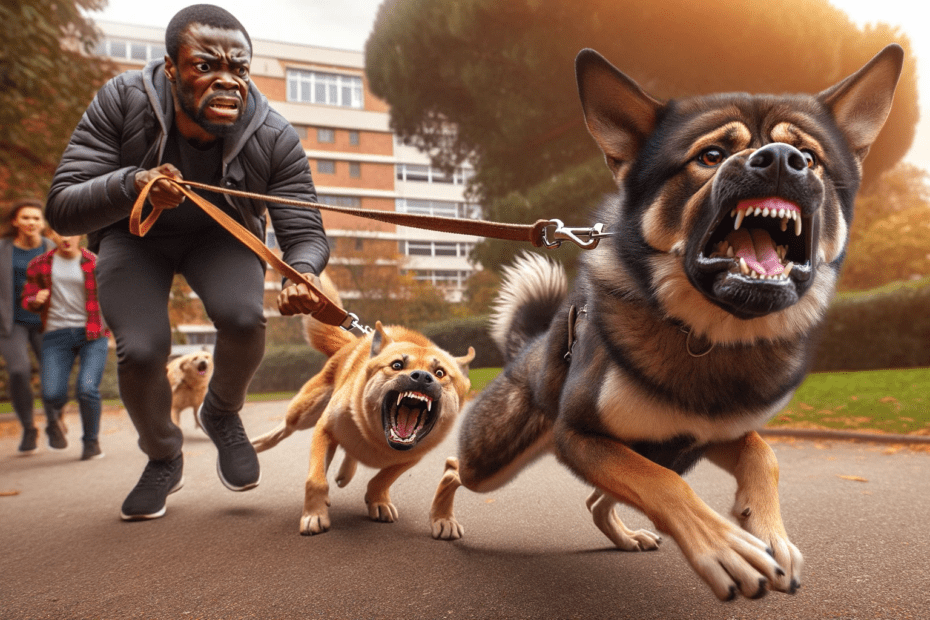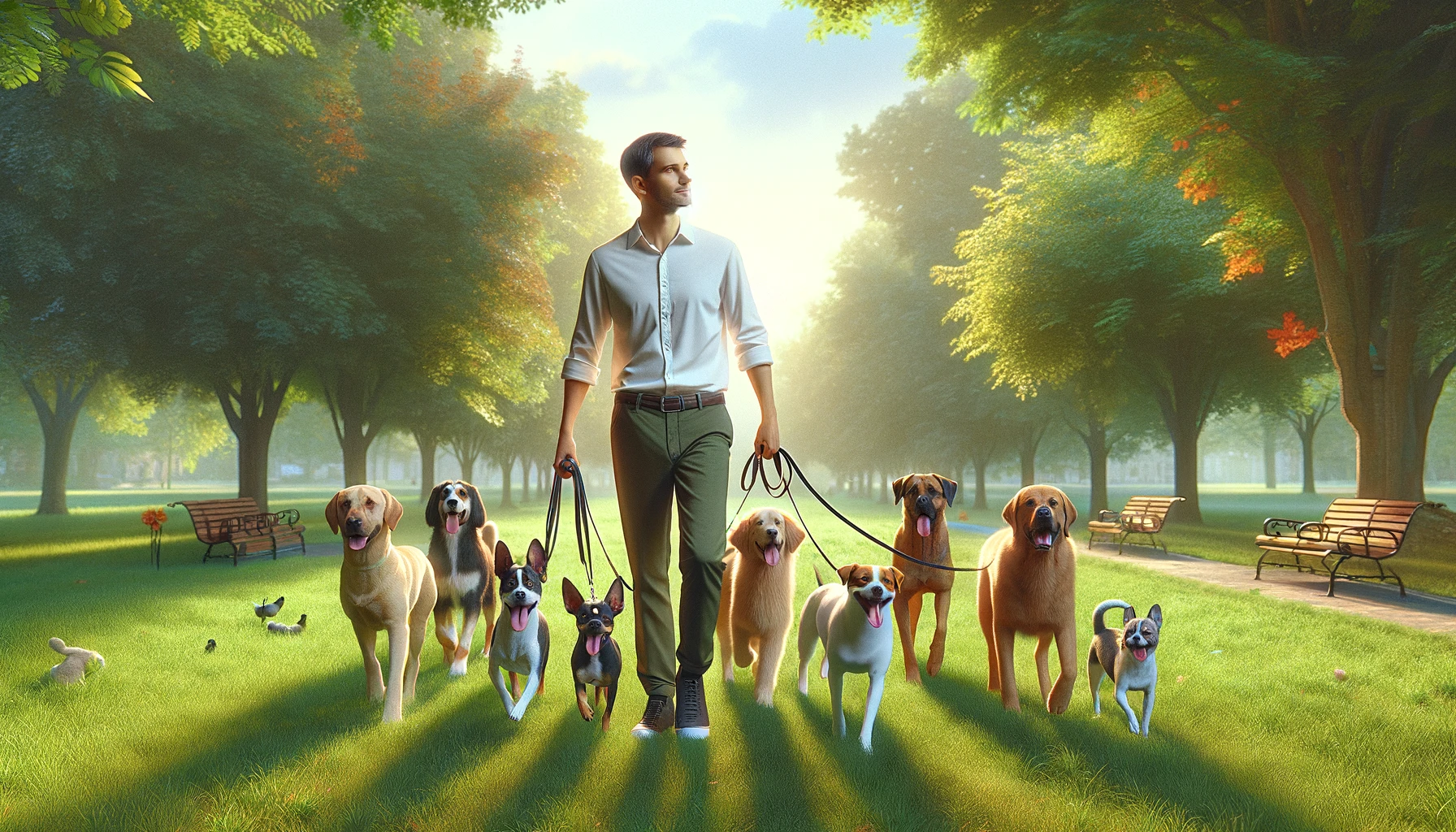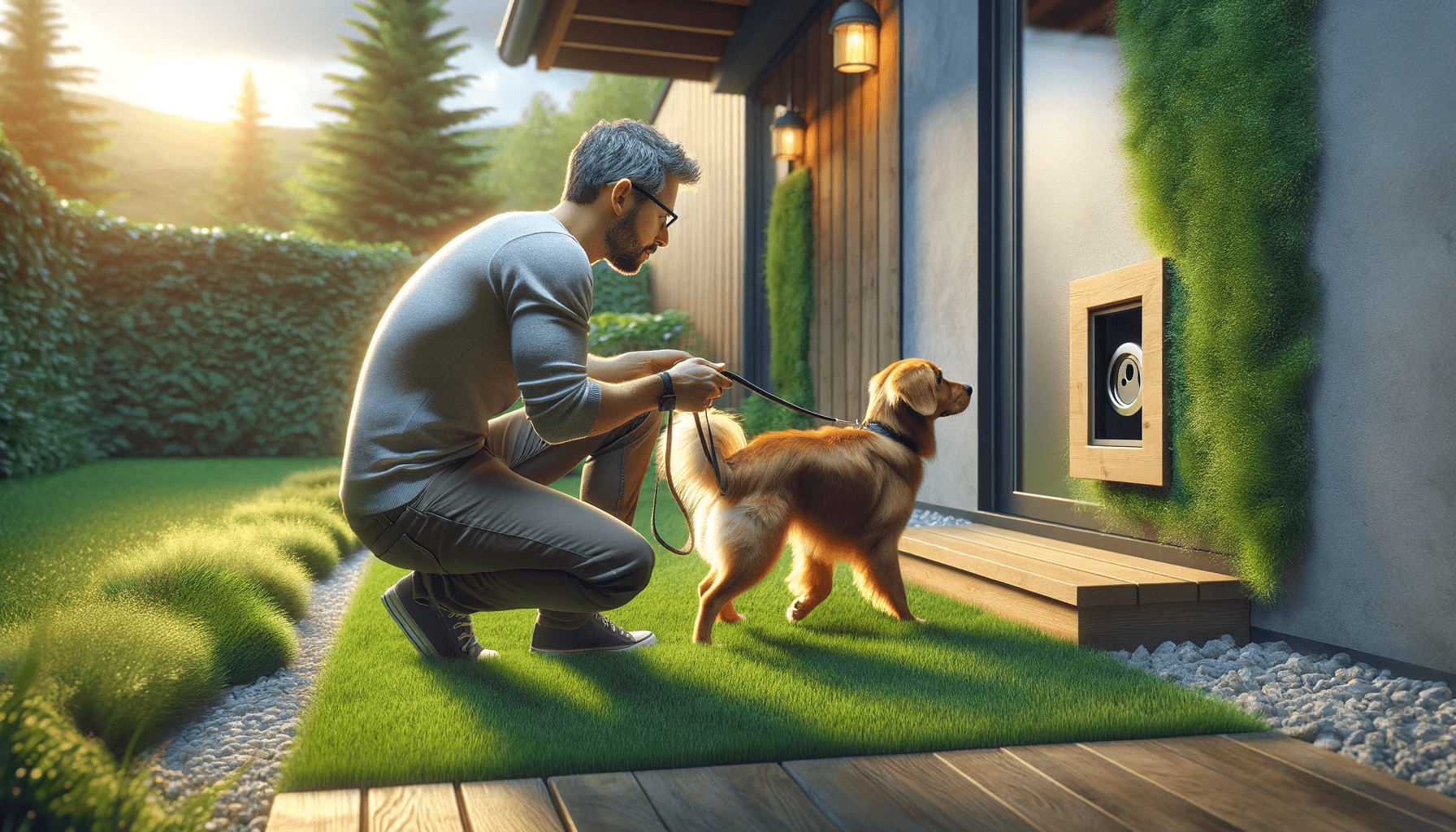Do you struggle with a leash reactive dog? It can be frustrating and overwhelming, but specialized training can make a world of difference. Understanding why your dog reacts on a leash is the first step towards helping them overcome this behavior.
In this article, we'll explore common triggers and effective techniques for leash reactive dogs. With positive reinforcement, counterconditioning, and desensitization exercises, you can help your furry friend become more confident and calm on walks.
Don't worry, help is available to guide you through this process.
Key Takeaways
- Leash reactivity in dogs is often triggered by fear, frustration, or a lack of socialization.
- Specialized training is necessary to effectively address leash reactivity.
- Regular obedience training may not be sufficient to modify reactive behaviors.
- Specialized training focuses on desensitization and counterconditioning techniques to help dogs remain calm and controlled in the presence of triggers.
The Importance of Leash Reactive Training
If you have a leash reactive dog, it's crucial for you to understand the importance of specialized training. Leash reactive dogs can display aggressive or fearful behavior when they see other dogs or strangers while on a leash. Consistency is key when it comes to leash reactive training. By consistently practicing positive reinforcement techniques and using desensitization exercises, you can help your dog learn to remain calm and focused while on a leash.
Building trust and confidence is also essential in leash reactive dogs. Through consistent training, you can help your dog develop trust in you as their handler and build their confidence in social situations. This can be achieved by gradually exposing your dog to various stimuli and rewarding them for calm behavior.
Remember, leash reactive training requires patience and time. It's important to remain calm and composed during training sessions, as your dog can pick up on your energy. By providing a safe and structured environment, you can help your leash reactive dog overcome their reactive tendencies and enjoy walks with you.
With specialized training, you can transform your leash reactive dog into a well-behaved and confident companion.
Understanding Leash Reactivity in Dogs
To understand leash reactivity in dogs, observe their behavior when encountering other dogs or strangers while on a leash. Leash reactivity refers to the negative or aggressive reactions that dogs exhibit when they're restrained by a leash. It's important to recognize the signs of leash reactivity in order to effectively manage and address this issue.
When a dog is leash reactive, their body language can provide valuable insight into their emotions and intentions. Signs of leash reactivity may include barking, lunging, growling, or pulling on the leash. These behaviors are often a result of fear, anxiety, or a perceived threat. Understanding your dog's body language can help you identify their triggers and implement strategies to manage their reactivity.
Managing leash reactivity at home is essential for the overall well-being of your dog. Providing a calm and structured environment can help reduce their anxiety and stress levels. Creating a safe space for your dog, such as a designated area with their favorite toys and bedding, can help them feel secure. Additionally, implementing positive reinforcement training techniques can help redirect their focus and reinforce desired behaviors.
Common Triggers for Leash Reactive Behavior
As you continue to understand leash reactivity in dogs, it's important to be aware of the common triggers that can lead to this reactive behavior. Recognizing these triggers is the first step in managing leash reactive behavior effectively.
One of the main causes of leash reactivity is fear or anxiety. Dogs may become reactive when they feel threatened or overwhelmed by unfamiliar people, animals, or environments. This fear can stem from a lack of socialization or negative past experiences.
Another common trigger is frustration. Dogs that are unable to approach or interact with something they desire, like another dog or a squirrel, can become reactive due to their frustration.
Additionally, some dogs may display leash reactivity due to a lack of impulse control. They may struggle to contain their excitement when they see something stimulating, such as a jogger or a moving car. This lack of control can lead to reactive behavior on the leash.
Understanding the triggers that cause leash reactivity is crucial in managing and addressing this behavior. With specialized training, you can learn techniques to help your dog remain calm and focused on walks, reducing their reactivity and creating a more enjoyable experience for both of you.
Positive Reinforcement Techniques for Leash Reactive Dogs
To effectively train leash reactive dogs, utilize positive reinforcement techniques. These methods focus on rewarding desired behaviors rather than punishing unwanted ones. By using positive reinforcement, you can create a positive association with the triggers that cause your dog's reactive behavior, ultimately helping them become more calm and confident on walks.
Here are four effective positive reinforcement techniques for leash reactive dogs:
- Counter-conditioning: This technique involves pairing the presence of the trigger with something your dog loves, such as treats or toys. Gradually, your dog will start to associate the trigger with positive experiences, leading to a change in their emotional response.
- Clicker training: Using a clicker, you can mark the exact moment your dog exhibits a desired behavior and then reward them. This clear communication helps your dog understand what they're being rewarded for, reinforcing the desired behavior.
- Desensitization: By gradually exposing your dog to the trigger at a distance they're comfortable with and gradually reducing the distance over time, you can help them become less reactive. Pairing this with positive reinforcement helps your dog learn that the trigger isn't something to fear.
- Focus and redirection: Teaching your dog to focus on you and redirect their attention away from the trigger can be extremely helpful. Rewarding them for maintaining their focus on you during a trigger situation can help them feel more secure and less reactive.
Counterconditioning Strategies for Leash Reactive Dogs
Continue building your leash reactive dog's confidence and calmness by implementing effective counterconditioning strategies. Counterconditioning techniques can help in managing leash reactive behavior and reducing your dog's anxiety and fear. These strategies focus on changing your dog's emotional response to triggers that cause the reactive behavior.
One effective counterconditioning technique is desensitization. This involves gradually exposing your dog to the trigger at a distance where they feel comfortable and relaxed. By pairing the trigger with positive experiences, such as treats or play, you can help your dog associate the trigger with something positive, gradually reducing their reactivity.
Another technique is called classical conditioning. This involves pairing the trigger with something that your dog already loves and enjoys, such as their favorite toy or a tasty treat. Over time, your dog will start to associate the trigger with the positive experience, leading to a more positive emotional response.
It is important to be patient and consistent when implementing these counterconditioning strategies. Start at a distance where your dog remains calm and gradually decrease the distance as they become more comfortable. Remember to reward your dog for calm and relaxed behavior, reinforcing the positive associations.
Desensitization Exercises for Leash Reactive Dogs
Implement desensitization exercises to help your leash reactive dog overcome their triggers and gain confidence. Desensitization training methods are a crucial component of managing leash reactive dogs, as they help to gradually reduce your dog's sensitivity to their triggers. By exposing your dog to their triggers in a controlled and safe environment, you can help them learn to associate these triggers with positive experiences, ultimately changing their emotional response.
To effectively desensitize your leash reactive dog, consider the following exercises:
- Counter-conditioning: Pair your dog's triggers with high-value rewards, such as treats or toys, to create positive associations.
- Gradual exposure: Start by exposing your dog to their triggers at a distance where they remain calm and relaxed. Slowly decrease the distance over time, allowing your dog to acclimate gradually.
- Controlled environments: Practice desensitization exercises in controlled environments, such as a quiet park or your backyard, to minimize distractions and ensure your dog's safety.
- Consistency and patience: Desensitization takes time and patience. Be consistent with your training sessions and gradually increase the difficulty level as your dog progresses.
Tools and Equipment to Aid in Leash Reactive Training
Now let's talk about the tools and equipment that can assist you in leash reactive training.
Effective training aids, such as head halters or front-clip harnesses, can provide better control and help redirect your dog's attention. When choosing between a harness and a collar, consider your dog's specific needs and comfort level.
Additionally, varying leash lengths can offer flexibility and better management during training sessions.
Effective Training Aids
To effectively train your leash reactive dog, you'll need specific tools and equipment designed to aid in their training. These training aids are essential for leash reactivity management and preventing leash aggression. Here are four effective training aids that can help you in your journey:
- Gentle Leader or Head Halter: This tool provides control over your dog's head, allowing you to redirect their attention and discourage pulling or lunging.
- Front-Clip Harness: This harness is designed to discourage pulling by redirecting your dog's forward movement. It gives you better control and reduces the chances of your dog reacting aggressively.
- Treat Pouch: A treat pouch allows you to have easy access to high-value treats during training sessions. It helps in rewarding your dog's positive behavior and reinforcing good habits.
- Long Training Leash: A longer leash provides your dog with more freedom while still maintaining control. It allows you to gradually increase their exposure to triggers and work on their reactions in a controlled environment.
Harness Vs. Collar
When choosing tools and equipment to aid in leash reactive training, it's important to compare the benefits of harnesses and collars.
Harnesses have several advantages when it comes to leash reactive dogs. Firstly, they distribute the pressure evenly across the dog's chest, reducing the strain on their neck and throat. This is particularly beneficial for dogs with respiratory issues or those prone to pulling. Additionally, harnesses provide better control over the dog's movements, which can be crucial in redirecting their attention during reactive episodes.
On the other hand, collars have certain limitations. They can put excessive pressure on the dog's neck and exacerbate any existing health issues. Furthermore, collars may cause discomfort and hinder effective training due to the dog's natural instinct to pull against the pressure.
Therefore, when dealing with leash reactive dogs, harnesses are generally considered a safer and more effective tool for training.
Leash Length Options
For leash reactive dogs, there are various leash length options available as tools and equipment to aid in their specialized training. Finding the right leash length is essential in managing leash reactive behavior and ensuring the safety of both you and your dog.
Here are some leash length considerations and leash handling techniques to help you in your training journey:
- Short leash: A short leash provides better control and allows you to keep your dog close. It can help prevent your dog from lunging or reacting to stimuli.
- Long leash: A longer leash, such as a 6-foot or 10-foot leash, can give your dog more freedom to explore while still maintaining some control. This can be helpful for desensitization exercises.
- Retractable leash: Retractable leashes offer adjustable lengths, which can be useful for gradually increasing your dog's exposure to triggers at a safe distance.
- Hands-free leash: Hands-free leashes, such as waist belts or crossbody leashes, can give you more freedom of movement and allow you to focus on training rather than managing the leash.
Seeking Professional Help for Leash Reactive Dogs
When it comes to dealing with leash reactive dogs, seeking professional help is essential.
An expert trainer can provide you with the guidance and support needed to address your dog's behavior effectively. They possess the knowledge and experience to understand the underlying causes of leash reactivity and can implement training techniques that are tailored to your dog's specific needs.
Expert Guidance Essential
To effectively address leash reactivity in dogs, seeking expert guidance is essential. Professional help can provide you with the knowledge and skills needed to manage and train your leash reactive dog effectively. Here are some reasons why seeking expert guidance is crucial:
- Specialized Knowledge: Trainers who specialize in leash reactive dogs have extensive experience and knowledge in dealing with this specific issue.
- Individualized Approach: An expert can create a customized training plan tailored to your dog's specific needs and personality.
- Effective Techniques: Professionals use proven techniques that are designed to address leash reactivity and help your dog overcome their fear or aggression.
- Support and Guidance: Having an expert by your side can provide you with the support and guidance needed during the training process, ensuring that you stay on track and make progress.
Understanding Dog's Behavior
Seeking professional help for your leash reactive dog can provide valuable insight into understanding their behavior. A skilled trainer or behaviorist can observe your dog's body language and interpret their signals accurately. They'll help you identify the triggers that cause your dog to react on a leash and teach you how to manage these situations effectively.
Understanding your dog's behavior is crucial in addressing leash reactivity. By learning to read their body language, you can anticipate their reactions and take proactive measures to prevent them.
Additionally, a professional can guide you in implementing management strategies at home. This may involve creating a calm and structured environment, providing mental and physical stimulation, and practicing positive reinforcement training techniques.
With expert guidance, you can gain a deeper understanding of your leash reactive dog's behavior and work towards a happier and more harmonious relationship.
Effective Training Techniques
If you want to effectively train your leash reactive dog, it's essential to seek specialized help from a professional trainer or behaviorist. They have the knowledge and expertise to address your dog's specific needs and develop a training plan tailored to their behavior.
Here are some effective training techniques they may use:
- Positive Reinforcement: Using rewards such as treats, toys, or praise to reinforce desired behaviors can help your dog associate positive experiences with good behavior.
- Consistency: Consistency is key in training. By establishing clear rules and expectations and consistently enforcing them, your dog will learn what's expected of them.
- Avoid Punishment: Punishment-based training methods can be counterproductive and may increase fear or aggression in leash reactive dogs. Positive reinforcement focuses on rewarding good behavior rather than punishing bad behavior.
- Desensitization and Counterconditioning: Gradually exposing your dog to triggers in a controlled environment and pairing them with positive experiences can help reduce their reactivity over time.
Frequently Asked Questions
Can Leash Reactivity Be Completely Eliminated Through Training?
Yes, leash reactivity can be completely eliminated through training. With the right techniques and consistency, you can help your dog become more comfortable and calm on the leash. Medication may not always be necessary, but consult with a professional to determine the best approach.
How Long Does It Typically Take to See Improvements in a Leash Reactive Dog?
Improvements in a leash reactive dog's behavior can vary depending on factors such as their history, breed, and individual temperament. Techniques like desensitization and counter-conditioning can help manage leash reactivity.
Are Certain Breeds More Prone to Leash Reactivity Than Others?
Certain breeds may be more prone to leash reactivity, which is when a dog becomes reactive or aggressive while on a leash. Understanding the role of genetics can help in addressing and managing this behavior.
Can Leash Reactivity Be Caused by a Traumatic Event or Past Experience?
Leash reactivity can be caused by a traumatic event or past experience. It's important to understand this when considering why leash reactive dogs need specialized training. With proper guidance, they can learn to overcome their fear and react more positively.
Is It Possible for a Dog to Become Leash Reactive Suddenly, Even if They Have Never Shown Signs Before?
Yes, it is possible for a dog to suddenly become leash reactive, even if they've never shown signs before. Leash reactivity can be triggered by a medical condition or physical discomfort. Different training techniques may work better for leash reactive dogs compared to others.
Conclusion
In conclusion, specialized training is crucial for leash reactive dogs. By understanding leash reactivity and its triggers, using positive reinforcement techniques, and implementing counterconditioning and desensitization exercises, we can help these dogs overcome their reactive behavior.
Additionally, utilizing tools and equipment designed for leash reactive training can greatly aid in the process. If you're struggling with a leash reactive dog, don't hesitate to seek professional help. With the right training and support, these dogs can learn to walk calmly on a leash and enjoy their walks without fear or aggression.






